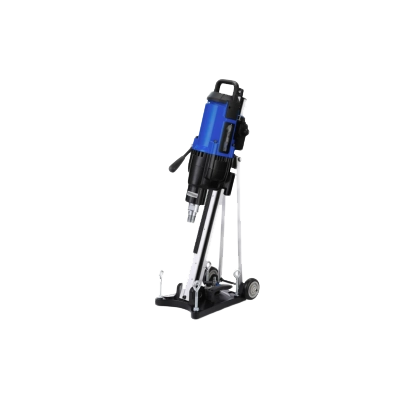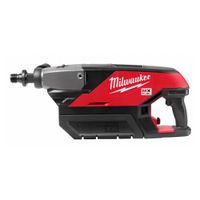Call +(254) 703 030 000 / 751 483 999 / 721 704 777
- Home
- Tools
- Power Tools
- Drills Drivers
- Core Drills Stands
.....Read More
Frequently Asked Questions
What is a core drill used for?
A core drill is a specialized tool used for drilling precise, cylindrical holes in various materials such as concrete, stone, asphalt, wood, and metal. It is commonly employed in construction, mining, and geological exploration. The primary purpose of a core drill is to extract a core sample, which is a cylindrical section of the material being drilled. This sample can be analyzed for various properties, such as composition, strength, and structural integrity.
In construction, core drills are used to create openings for utility installations, such as plumbing, electrical conduits, and HVAC systems. They are also used for installing anchor bolts and dowels, as well as for creating holes for pipes and cables. Core drilling is preferred in these applications because it produces clean, precise holes with minimal damage to the surrounding material.
In geological exploration, core drills are used to obtain samples from the earth's subsurface. These samples help geologists and engineers assess the composition and structure of the ground, which is crucial for resource exploration, environmental studies, and construction planning.
In the mining industry, core drilling is used to explore mineral deposits. By analyzing the core samples, mining companies can determine the location, quality, and quantity of minerals present, which aids in planning extraction operations.
Core drills can be handheld or mounted on rigs, and they use diamond or carbide drill bits to cut through hard materials. The choice of drill bit depends on the material being drilled and the desired precision of the hole. Core drilling is valued for its efficiency, accuracy, and ability to produce minimal dust and debris compared to other drilling methods.
How does a core drill work?
A core drill is a specialized tool used to remove a cylindrical section of material, known as a core, from a larger solid. It operates using a hollow, cylindrical drill bit, which is often coated with diamond or carbide to enhance cutting efficiency and durability. The core drill is typically powered by electricity, hydraulics, or air pressure, depending on the application and material being drilled.
The process begins with the drill bit being positioned at the desired drilling location. As the drill is activated, the bit rotates at high speed, cutting into the material. The hollow center of the bit allows the core to be extracted as the drill penetrates deeper. Water or another coolant is often used during the drilling process to reduce heat generated by friction, minimize dust, and prolong the life of the drill bit.
Core drills are commonly used in construction, geology, and engineering for tasks such as creating holes for pipes, cables, or anchor bolts, and for extracting samples from concrete, rock, or soil for analysis. The precision and efficiency of core drilling make it an essential tool for projects requiring accurate, clean cuts without causing damage to the surrounding material.
What are the differences between cordless and corded core drills?
Cordless core drills are powered by rechargeable batteries, offering greater mobility and convenience as they are not tethered to a power outlet. This makes them ideal for use in remote locations or areas without easy access to electricity. They are generally lighter and more portable, allowing for easier handling and maneuverability. However, their power output and runtime are limited by battery capacity, which may require frequent recharging or battery swaps during extended use.
Corded core drills, on the other hand, are powered by a direct connection to an electrical outlet, providing a continuous and consistent power supply. This allows for higher power output, making them suitable for heavy-duty drilling tasks and prolonged use without interruptions. Corded drills are typically more powerful and can handle larger diameter bits and tougher materials more effectively than their cordless counterparts. However, their reliance on a power cord can limit mobility and make them less convenient in areas without nearby power sources.
In summary, the choice between cordless and corded core drills depends on the specific needs of the user. Cordless drills offer flexibility and ease of use in various locations, while corded drills provide sustained power and efficiency for demanding tasks.
What safety precautions should be taken when using a core drill?
1. **Personal Protective Equipment (PPE):** Wear safety goggles, ear protection, gloves, and a dust mask or respirator to protect against debris, noise, and dust.
2. **Training and Familiarity:** Ensure operators are trained and familiar with the core drill's operation and safety features.
3. **Inspect Equipment:** Check the drill and core bits for damage or wear before use. Ensure all parts are securely fastened.
4. **Secure the Work Area:** Clear the area of unnecessary personnel and obstacles. Use barriers or signs to prevent unauthorized access.
5. **Proper Setup:** Secure the drill stand firmly to the surface to prevent movement. Use anchors or a vacuum base as needed.
6. **Electrical Safety:** Use a Ground Fault Circuit Interrupter (GFCI) for electric drills. Ensure cords are in good condition and avoid wet conditions.
7. **Water Supply:** For wet drilling, ensure a continuous water supply to cool the bit and suppress dust. Avoid water contact with electrical components.
8. **Ventilation:** Ensure adequate ventilation in enclosed spaces to prevent dust accumulation and ensure operator comfort.
9. **Correct Bit Selection:** Use the appropriate core bit for the material being drilled to prevent damage and ensure efficiency.
10. **Controlled Operation:** Start drilling at a low speed to position the bit, then increase speed gradually. Apply steady, even pressure without forcing the drill.
11. **Monitor Drill Performance:** Watch for signs of overheating or binding. Stop immediately if the drill behaves erratically.
12. **Emergency Procedures:** Be aware of emergency shut-off procedures and have a first aid kit readily available.
13. **Post-Operation Checks:** After use, clean the equipment, inspect for damage, and store properly to maintain its condition.
How do you choose the right core drill bit for a specific material?
To choose the right core drill bit for a specific material, consider the following factors:
1. **Material Type**: Identify the material you are drilling into, such as concrete, asphalt, tile, stone, or metal. Different materials require different types of drill bits.
2. **Bit Material**: Select the appropriate bit material. Diamond core bits are ideal for hard materials like concrete and stone, while carbide-tipped bits are suitable for softer materials like brick and tile.
3. **Diameter and Length**: Determine the required diameter and length of the core bit based on the size of the hole you need. Ensure the bit is long enough to penetrate the material's thickness.
4. **Drill Type**: Match the core bit with the type of drill you are using. Handheld drills may require different bits compared to rig-mounted drills.
5. **Wet vs. Dry Drilling**: Decide between wet and dry drilling. Wet drilling, which uses water to cool the bit and reduce dust, is often preferred for concrete and masonry. Dry drilling is suitable for smaller jobs or when water use is impractical.
6. **Speed and Power**: Consider the drill's speed and power. High-speed drills require bits that can withstand rapid rotation without overheating or wearing out quickly.
7. **Quality and Brand**: Opt for high-quality bits from reputable brands to ensure durability and efficiency. Cheaper bits may wear out faster and result in poor performance.
8. **Project Scale**: For large-scale projects, invest in more durable, professional-grade bits. For smaller, occasional tasks, standard bits may suffice.
9. **Cost**: Balance cost with quality. While higher-quality bits may be more expensive, they often provide better performance and longevity.
By considering these factors, you can select the most suitable core drill bit for your specific material and project requirements.
What maintenance is required for a core drill?
Regular maintenance for a core drill includes the following steps:
1. **Cleaning**: After each use, clean the drill to remove dust, debris, and slurry. Use a brush and water to clean the drill bit and body, ensuring no residue is left that could cause corrosion or damage.
2. **Inspection**: Regularly inspect the drill for wear and tear. Check the drill bit for dullness or damage, and replace it if necessary. Examine the motor, power cords, and connections for any signs of wear or damage.
3. **Lubrication**: Lubricate moving parts as per the manufacturer's recommendations to ensure smooth operation. This includes bearings and any other components that require lubrication to prevent friction and wear.
4. **Coolant System**: If the drill uses a coolant system, ensure it is functioning properly. Check hoses and connections for leaks, and ensure the coolant reservoir is filled with the appropriate fluid.
5. **Alignment and Calibration**: Periodically check the alignment and calibration of the drill to ensure accuracy. Misalignment can lead to inefficient drilling and increased wear on the drill bit.
6. **Electrical Components**: Inspect electrical components for any signs of damage or wear. Ensure that all connections are secure and that there are no exposed wires.
7. **Storage**: Store the drill in a dry, clean environment to prevent rust and corrosion. Use protective covers if available.
8. **Manual and Manufacturer Guidelines**: Always refer to the user manual and follow the manufacturer's maintenance guidelines for specific instructions and intervals.
9. **Professional Servicing**: Schedule regular professional servicing to address any complex issues and ensure the drill is in optimal working condition.
By following these maintenance steps, you can extend the lifespan of your core drill and ensure it operates efficiently and safely.
Can core drills be used for both vertical and horizontal drilling?
Yes, core drills can be used for both vertical and horizontal drilling. Core drills are versatile tools designed to extract cylindrical samples from various materials such as concrete, rock, or masonry. They are equipped with diamond-tipped drill bits that can cut through hard surfaces efficiently.
For vertical drilling, core drills are typically mounted on a stand or rig to ensure stability and precision. This setup is commonly used in construction and geological exploration to obtain core samples for analysis or to create openings for pipes and cables.
Horizontal drilling with core drills is also feasible, though it may require additional equipment or adjustments. Portable core drills or handheld models are often used for horizontal applications, allowing operators to maneuver the drill into position. In some cases, specialized rigs or mounts are employed to maintain alignment and control during the drilling process.
Both vertical and horizontal core drilling require careful planning and execution to ensure safety and accuracy. Factors such as drill bit size, material hardness, and drilling speed must be considered to achieve optimal results. Additionally, proper cooling and lubrication are essential to prevent overheating and extend the life of the drill bit.
In summary, core drills are adaptable tools capable of performing both vertical and horizontal drilling tasks, provided the appropriate equipment and techniques are employed.



